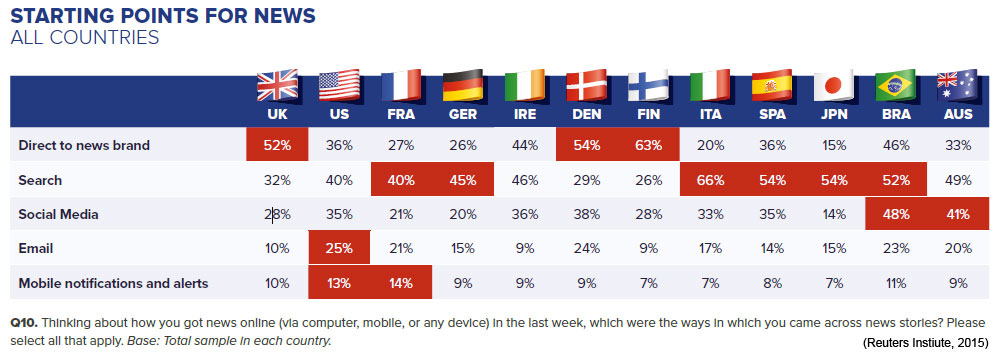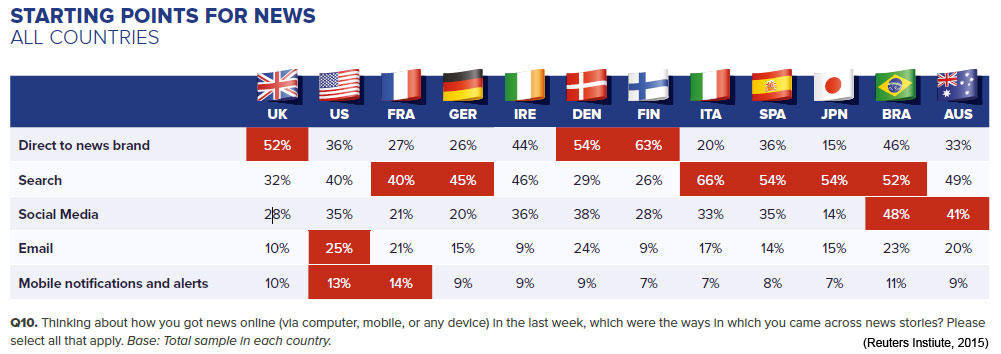
Consumption of news continues to shift from traditional broadcast and print to digitally native media accessed through mobile devices and social media channels. However, the pathways to a radically altered news future do not appear to be linear. Even in 2015, television remains the leading source of news for many U.S. media consumers, especially with regard to local news. Explosive micro-trends observed in prior years — for example, the early rise in news outlets’ native apps; the sharp increase in usage of tablet devices seen two years ago in the United States; and Twitter’s initial stages of spiky growth — have proven volatile, with upward trend-lines already beginning to plateau.
Meanwhile, “older” delivery technologies such as podcasting and email newsletters have returned in force; and U.S. nightly news broadcasts have actually gained audience over the past few years, even as some media observers (and advertisers) continue to lament the relative scarcity of high-quality, Web-based news video. Enthusiasm for a wave of newer digital news outlets may also prove to be premature, and emerging issues such as ad-blocking software may furnish new challenges for even the most forward-leaning business models. And that complicated overall picture is just in the United States. It is worth remembering that media-related patterns are far from evenly distributed globally, as different stages of economic development, cultural values and technology adoption habits can produce distinctive national media environments.
Media ecosystems were once relatively straightforward to evaluate through measurements such as Nielsen ratings and newspaper circulation figures. They are now more fragmented and hybrid, and increasingly difficult to characterize in broad strokes. Each year, though, several core institutions have taken to summing up the latest trends and putting these in context, becoming a kind of annual ritual of self-reflection for the news industry. In April, the Pew Research Center released its “State of the News Media 2015” report, which began with the following headline finding:
Call it a mobile majority. At the start of 2015, 39 of the top 50 digital news websites have more traffic to their sites and associated applications coming from mobile devices than from desktop computers, according to Pew Research Center’s analysis of comScore data.
In June 2015, the Reuters Institute for the Study of Journalism at the University of Oxford released its own “Digital News Report 2015,” which is based on representative surveys of news consumers conducted by YouGov. Among the dozen countries included in the global survey are the United States, Britain, Germany, France, Ireland, Italy, Spain, Denmark, Finland, urban Brazil, Japan and Australia. The report, authored by Nic Newman, David A.L. Levy and Rasmus Kleis Nielsen, largely corroborates Pew’s findings that the rise of mobile technologies and access, along with Facebook’s increasingly large role in social discovery, are the dominant emerging trends in the news business.
The report’s findings include:
- “Surprisingly, given the amount of time spent in apps generally, people in most countries say they are likely to access news via a mobile browser. This suggests that news may not always be a primary destination but will often be found through links from social media or email.”
- “On average people use a small number of trusted news sources on the mobile phone. The average across all countries is 1.52 per person, significantly fewer than on a tablet or computer. We also find that, even though 70% of smartphone users have a news app installed on their phone, only a third of respondents actually use them in a given week, reinforcing the difficulty many news brands have in cutting through on this crowded and very personal device.” In the United States, the average number of news apps is 1.5.
- “Across all our countries a quarter of our sample (25%) now say the smartphone is their main device for accessing digital news — up from 20% last year. That figure rises to two-fifths (41%) of those aged under 35.”
- The survey overall is “likely to underestimate the true levels of access to television news, but even so we can detect in the U.S. and U.K. some fall-off in topline figures…. This is particularly the case with the young where in the United States less than a third (31%) of under 45s now watch a scheduled TV [program] compared with 42% two years ago…. But the picture is not the same in all countries. TV viewing in Germany has hardly been affected; indeed it remains strong even with the young — 58% of under-35s still watch a scheduled [program] — while social media growth is less pronounced.”
- Americans showed the lowest levels of trust (32%) in news media of any country, and even with respect to respondents’ own go-to news sources, only 56% of Americans said they trusted those outlets. The report notes that “many of the countries with the highest levels of trust also have well-funded public service broadcasters.” Americans also recorded the highest level of interest in local news (52%) and among the lowest levels of interest in international news (46%).
- The data suggest that “Facebook is becoming increasingly dominant, with 41% [an increase of 6 percentage points over 2014] using the network to find, read, watch, share, or comment on the news each week — more than twice the usage of its nearest rival. The strong growth of both WhatsApp and Instagram — which are both popular with the young — has strengthened Facebook’s hold on social discovery in the last year.”
- The evidence also shows a “significant jump in the use of online news video in all countries except Germany and also in the U.S., where the big move happened between 2013 and 2014. We do still however find a number of constraints around the use of video news online. Of those who don’t use video, four in ten (40%) said they found reading quicker and more convenient, with 19% agreeing with the statement that videos rarely add anything useful to the text. Older groups are two-thirds as likely to express a preference for a bigger screen. Younger groups, who expect web applications to respond instantly, are more impatient about load times and about preroll advertisements getting in the way of content.”
“We see the smartphone more clearly as the defining device for digital news with a disruptive impact on consumption, formats, and business models,” the report notes. “Our data suggest it provides an environment dominated by a few successful brands, with others struggling to reach a wider audience, both via apps and browsers.”
Keywords: news, Twitter, Facebook

